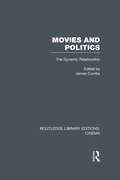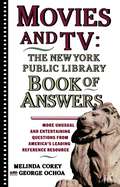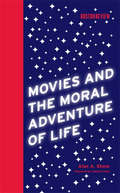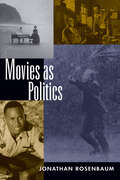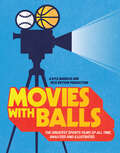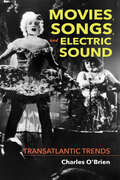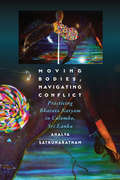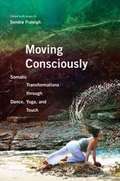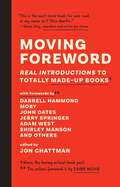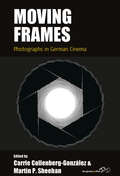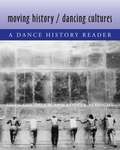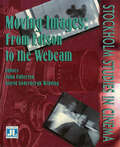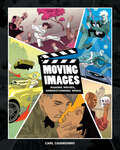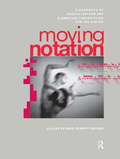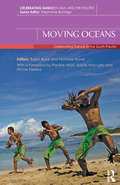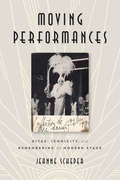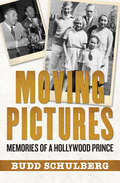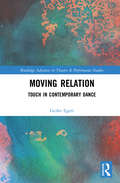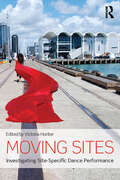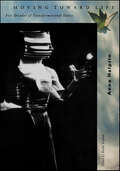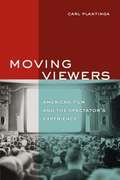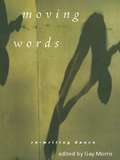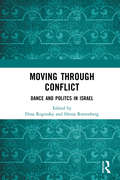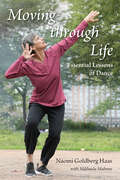- Table View
- List View
Movies and Politics: The Dynamic Relationship (Routledge Library Editions: Cinema)
by James CombsCollecting together some of the best thinking about the relationship between movies and politics, this book, originally published in 1993, encourages an awareness of the political dimension of film, both for film scholars and those entering the film industry. Eight essays are grouped into four parts addressing political ideology and movie narrative, political myth in the movies, political history and movie culture, and political communication and the movies. An introductory essay, as well as prefatory remarks to each of the four parts, brings additional insight and perspective and puts the essays into context.
Movies and TV: The New York Public Library Book of Answers
by George Ochoa Melinda Corey Diane CoreyIf you're a movie or television fan - how many of these questions can you answer? What was the last picture show in The Last Picture Show? Where was the stagecoach headed in Stagecoach? What was the name of the dinosaur bone in Bringing Up Baby? What did Gomer Pyle do before he entered the Marines? Who played Gentle Ben? Like The Book of Answers, this book answers hundreds of questions in one of the New York Public LIbrary Telephone Reference Service's most popular areas - film and television. It covers the biggest stars, breakthrough productions, famous on-and-off-screen incidents, and film and TV history and trivia. Movies and TV: The New York Public Library Book of Answers is both informative and entertaining - a treasure trove of fascinating movie and TV facts, a perfect companion to The Book of Answers, and a real treat for movie and TV fans.
Movies and the Moral Adventure of Life (Boston Review)
by Alan A. StoneEssays on small art films and big-budget blockbusters, including Antonia's Line, American Beauty, Schindler's List, and The Passion of the Christ, that view films as life lessons, enlarging our sense of human possibilities. For Alan Stone, a one-time Freudian analyst and former president of the American Psychiatric Society, movies are the great modern, democratic medium for exploring our individual and collective lives. They provide occasions for reflecting on what he calls “the moral adventure of life”: the choices people make—beyond the limits of their character and circumstances—in response to life's challenges. The quality of these choices is, for him, the measure of a life well lived. In this collection of his film essays, Stone reads films as life texts. He is engaged more by their ideas than their visual presentation, more by their power to move us than by their commercial success. Stone writes about both art films and big-budget Hollywood blockbusters. And he commands an extraordinary range of historical, literary, cultural, and scientific reference that reflects his impressive personal history: professor of law and medicine, football player at Harvard in the late 1940s, director of medical training at McLean Hospital, and advisor to Attorney General Janet Reno on behavioral science. In the end, Stone's enthusiasms run particularly to films that embrace the sheer complexity of life, and in doing so enlarge our sense of human possibilities: in Antonia's Line, he sees an emotionally vivid picture of a world beyond patriarchy; in Thirteen Conversations about One Thing, the power of sheer contingency in human life; and in American Beauty, how beauty in ordinary experience draws us outside ourselves, and how beauty and justice are distinct goods, with no intrinsic connection. Other films discussed in these essays (written between 1993 and 2006 for Boston Review) include Un Coeur en Hiver, Schindler's List, Pulp Fiction, Thirteen Days, the 1997 version of Lolita, The Battle of Algiers, The Passion of the Christ, Persuasion, and Water.
Movies as Politics
by Jonathan RosenbaumIn this new collection of reviews and essays, Jonathan Rosenbaum focuses on the political and social dynamics of the contemporary movie scene. Rosenbaum, widely regarded as the most gifted contemporary American commentator on the cinema, explores the many links between film and our ideological identities as individuals and as a society. Readers will find revealing examinations of, for example, racial stereotyping in the debates surrounding Do the Right Thing, key films from Africa, China, Japan, and Taiwan, Hollywood musicals and French serials, and the cultural amnesia accompanying cinematic treatments of the Russian Revolution, the civil rights movement, and the Vietnam War. From Schindler's List, Star Wars, Pulp Fiction, Forrest Gump, The Piano, and Ace Ventura: Pet Detective to the maverick careers of Orson Welles, Jacques Tati, Nicholas Ray, Chantal Akerman, Todd Haynes, and Andrei Tarkovsky, Rosenbaum offers a polemically pointed survey that makes clear the high stakes involved in every aspect of filmmaking and filmgoing.
Movies under the Influence
by Jocelyn Szczepaniak-GilleceA cultural history of the enduring relationship between film spectatorship and intoxicating substances Movies under the Influence charts the entangled histories of moviegoing and mind-altering substances from early cinema through the psychedelic 1970s. Jocelyn Szczepaniak-Gillece examines how the parallel trajectories of these two enduring aspects of American culture, linked by their ability to influence individual and collective consciousness, resulted in them being treated and regulated in similar ways. Rather than looking at representations of drug use within film, she regards cinema and intoxicants as kindred experiences of immersion that have been subject to corresponding forces of ideology and power. Exploring the effects of intoxicants such as caffeine, nicotine, alcohol, marijuana, and psychedelics on film spectatorship, Szczepaniak-Gillece demonstrates how American movie theaters sought to cultivate a dual identity, presenting themselves as both a place of wholesome entertainment and a shadowy zone of illicit behavior. Movies under the Influence highlights the various legislative, legal, and corporate powers that held sway over the darkened anonymity of theaters, locating the convergence of moviegoing and drug use as a site of mediation and social control in America. As much as substances and cinema are points where power intervenes, they are also settings of potential transcendence, and Movies under the Influence maintains this paradox as a necessary component of American film history. Recontextualizing a wide range of films, from Hollywood to the avant-garde, this book examines the implicit relationship intoxicants suggest between mass media, spectatorship, and governmental regulation and provides a new angle from which to understand cinema&’s lasting role in evolving American culture.
Movies with Balls: The Greatest Sports Films of All Time, Analyzed and Illustrated
by Kyle Bandujo Rick BrysonFeaturing original illustrations of fantasy memorabilia, ticket stubs, and playmaps, Movies with Balls will make you want to rewatch the movies you already love, and discover gems you&’ve never seen. Play ball!If you&’re the kind of fan who cheers every single time you watch Rocky beat Drago, or remembers who said &“Be the ball, Danny&” and &“If you build it, he will come,&” this is the book for you.Movies with Balls celebrates and analyzes more than two dozen of the greatest sports films of all time, with expert play-by-play and color commentary on the movies themselves and the athleticism they portray. You&’ll be transported into fictional arenas, stadiums, gyms, fields, and golf courses to relive the climactic moments from: CaddyshackThe NaturalField of DreamsDodgeballThe Karate KidRocky IVThe WaterboyBend it Like BeckhamCreedAnd many more!
Movies, Songs, and Electric Sound: Transatlantic Trends
by Charles O’BrienAn exploration of how the introduction of recorded music affected the production, viewing experience, and global export of movies.In Movies, Songs, and Electric Sound, Charles O’Brien examines American and European musical films created circa 1930, when the world’s sound-equipped theaters screened movies featuring recorded songs and filmmakers in the United States and Europe struggled to meet the artistic and technical challenges of sound production and distribution. The presence of singers in films exerted special pressures on film technique, lending a distinct look and sound to the films’ musical sequences. Rather than advancing a film’s plot, songs in these films were staged, filmed, and cut to facilitate the singer’s engagement with her or his public. Through an examination of the export market for sound films in the early 1930s, when German and American companies used musical films as a vehicle for competing to control the world film trade, this book delineates a new transnational context for understanding the Hollywood musical. Combining archival research with the cinemetric analysis of hundreds of American, German, French, and British films made between 1927 and 1934, O’Brien provides the historical context necessary for making sense of the aesthetic impact of changes in film technology from the past to the present.“Movies, Songs, and Electric Sound is an insightful study in the beginning of cinema’s sound era.” —popcultureshelf.com
Moving Bodies, Navigating Conflict: Practicing Bharata Natyam in Colombo, Sri Lanka
by Ahalya SatkunaratnamMoving Bodies, Navigating Conflict is a groundbreaking ethnographic examination of dance practice in Colombo, Sri Lanka, during the civil war (1983–2009). It is the first book of scholarship on bharata natyam (a classical dance originating in India) in Sri Lanka, and the first on the role of this dance in the country's war. Focusing on women dancers, Ahalya Satkunaratnam shows how they navigated conditions of conflict and a neoliberal, global economy, resisted nationalism and militarism, and advocated for peace. Her interdisciplinary methodology combines historical analysis, methods of dance studies, and dance ethnography.
Moving Consciously: Somatic Transformations through Dance, Yoga, and Touch
by Sondra FraleighThe popularity of yoga and Zen meditation has heightened awareness of somatic practices. Individuals develop the conscious embodiment central to somatics work via movement and dance, or through touch from a skilled teacher or therapist often called a somatic bodyworker. Methods of touch and movement foster generative processes of consciousness in order to create a fluid interconnection between sensation, thought, movement, and expression. In Moving Consciously , Sondra Fraleigh gathers essays that probe ideas surrounding embodied knowledge and the conscious embodiment of movement and dance. Using a variety of perspectives on movement and dance somatics, Fraleigh and other contributors draw on scholarship and personal practice to participate in a multifaceted investigation of a thriving worldwide phenomenon. Their goal: to present the mental and physical health benefits of experiencing one's inner world through sensory awareness and movement integration. A stimulating addition to a burgeoning field, Moving Consciously incorporates concepts from East and West into a timely look at life-changing, intertwined practices that involve dance, movement, performance studies, and education. Contributors: Richard Biehl, Robert Bingham, Hillel Braude, Alison East, Sondra Fraleigh, Kelly Ferris Lester, Karin Rugman, Catherine Schaeffer, Jeanne Schul, and Ruth Way.
Moving Foreword: Real Introductions to Totally Made-Up Books
by Jon ChattmanA great foreword is more than just a few pages of self-indulgent frippery that comes before a book. A great foreword adds zest. It sets the stage for the page turner you're about to open, and perhaps even puts you in the locked room where a mystery happens or in the high-button shoes of a year gone by. A great foreword—sometimes—is even better than the book it precedes. So why not skip the boring actual-book part? Moving Foreword is a collection of introductions to imaginary books, written by real celebrities, comedians, musicians, and other writers with something to say. With a real foreword by Rainn Wilson, this book offers a no-holds-barred cacophony of laugh-out-loud funny, poignant, and thought-provoking writing that tackles everything from politics to pop culture, true crime to trout fishing, and Star Wars to skin flicks. Highlights include: Bustin' Through: Confessions of a Kool-Aid Man Foreword by "Pop Candy" columnist Whitney Matheson Phil Rosenthal's Who's the Boss?: My Unlikely Rise to Rock Stardom Foreword by "Bruce Springsteen" (Phil Rosenthal) Keep Your Gaze on Me: A True Story of Social Media, Obsession, and Murder Foreword by Shirley Manson, lead vocalist of Garbage Sock Puppet Mozart: The Life and Gruesome Death of Randy Masterson Foreword by actor Thomas Lennon Vance DeGeneris: An Unauthorized Biography Foreword by Vance DeGeneres Everything You Need to Know About Massachusetts Fish and Wildlife Regulations Foreword by New Kids on the Block member Jonathan Knight Fly Ball: How the New York Yankees Have Changed Lives Foreword by talk show host Jerry Springer Terrible Band Names: A Chronology of Rock History Foreword by John Ondrasik, a.k.a. Five for Fighting God's Wow, You're All F***ing This Up Big Time Foreword by singer-songwriter Mary Lambert . . . any many more!
Moving Frames: Photographs in German Cinema (Film Europa #26)
by Carrie Collenberg-González Martin P. SheehanAs the building blocks of moving pictures, photographs have played an integral role in cinema since the dawn of the medium—a relationship that has grown more complexly connected even as the underlying technologies continue to evolve. Moving Frames explores the use of photographs in German films from Expressionism to the Berlin School, addressing the formal and narrative roles that photographs play as well as the cultural and historical contexts out of which these films emerged. Looking beyond and within the canon, the editors gather stimulating new insights into the politics of surveillance, resistance, representation, and collective memory functioning through photographic rupture and affect in German cinema.
Moving History/Dancing Cultures
by Ann Cooper Albright Ann DilsThis new collection of essays surveys the history of dance in an innovative and wide-ranging fashion. Editors Dils and Albright address the current dearth of comprehensive teaching material in the dance history field through the creation of a multifaceted, non-linear, yet well-structured and comprehensive survey of select moments in the development of both American and World dance. This book is illustrated with over 50 photographs, and would make an ideal text for undergraduate classes in dance ethnography, criticism or appreciation, as well as dance history--particularly those with a cross-cultural, contemporary, or an American focus. The reader is organized into four thematic sections which allow for varied and individualized course use: Thinking about Dance History: Theories and Practices, World Dance Traditions, America Dancing, and Contemporary Dance: Global Contexts. The editors have structured the readings with the understanding that contemporary theory has thoroughly questioned the discursive construction of history and the resultant canonization of certain dances, texts and points of view. The historical readings are presented in a way that encourages thoughtful analysis and allows the opportunity for critical engagement with the text. Ebook Edition Note: Ebook edition note: Five essays have been redacted, including "The Belly Dance: Ancient Ritual to Cabaret Performance," by Shawna Helland; "Epitome of Korean Folk Dance", by Lee Kyong-Hee; "Juba and American Minstrelsy," by Marian Hannah Winter; "The Natural Body," by Ann Daly; and "Butoh: 'Twenty Years Ago We Were Crazy, Dirty, and Mad',"by Bonnie Sue Stein. Eleven of the 41 illustrations in the book have also been redacted.
Moving Images: From Edison to the Webcam (Stockholm Studies in Cinema)
by John Fullerton, Astrid Söderbergh WiddingSeventeen essays examining the impact of new media on the history of cinema.In 1888, Thomas Edison announced that he was experimenting on “an instrument which does for the eye what the phonograph does for the ear, which is the recording and reproduction of things in motion.” Just as Edison’s investigations were framed in terms of the known technologies of the phonograph and the microscope, the essays in this collection address the contexts of innovation and reception that have framed the development of moving images in the last one hundred years. Three concerns are of particular interest: the contexts of innovation and reception for moving image technologies; the role of the observer, whose vision and cognitive processes define some of the limits of inquiry and epistemological insight; and the role of new media, which, engaging with the domestic sphere as cultural interface, are transforming our understanding of public and private spheres.The seventeen previously unpublished essays in Moving Images represent the best of current research in the history of this field. They make a timely and stimulating contribution to debates concerning the impact of new media on the history of cinema.Contributors include: William Boddy, Carlos Bustamante, Warren Buckland, Valeria Camporesi, Bent Fausing, Oliver Gaycken, Alison Griffiths, Christopher Hales, Jan Holmberg, Solveig Jülich, Frank Kessler, Jay Moman, Sheila C. Murphy, Pelle Snickars, Paul C. Spehr, Björn Thuresson, and Åke Walldius.
Moving Images: Making Movies, Understanding Media
by Carl CasinghinoMedia literacy, collaborative team building, creative problem solving, project management: these cross-curricular skills are among the most vital for students today, and they form the core of Moving Images: Making Movies, Understanding Media. Moving Images is a comprehensive media studies and motion picture production textbook designed for effective classroom use in secondary schools and introductory undergraduate courses. Students of the twenty-first century need to develop skills in understanding, interpreting, and using moving image media, as has been established by publications of the National Standards for the English Language Arts, Common Sense Media, National Institutes of Health, and state guidelines across America. Young people today face a dizzying array of images and sounds, and it is crucial that they develop abilities to evaluate and utilize the messages and tools of moving image media.
Moving Notation (Performing Arts Studies #Vol. 6)
by Jill Beck Joseph ReiserDesigned specifically for university-level study, Moving Notation will benefit students and teachers of both dance and music, offering a complete introduction to the theory and practice of musical rhythm and elementary Labanotation. Performing Arts Studies aims to provide stimulating resource books of both a practical and philosophical nature for teachers and students of the performing arts: music, dance, theatre, film, radio, video, oral poetry, performance art, and multi-media forms.
Moving Oceans: Celebrating Dance in the South Pacific (Celebrating Dance in Asia and the Pacific)
by Nicholas Rowe Ralph BuckCelebrating the diversity of dance across the South Pacific, this volume studies the various experiences, motivations and aims for dance, emerging from the voices of dance professionals in the islands. In particular, it focuses on the interplay of cultures and pathways of migration as people move across the region discovering new routes and connections.
Moving Performances: Divas, Iconicity, and Remembering the Modern Stage
by Jeanne ScheperFabulous yet fierce, imperious yet impetuous, boss yet bitchy—divas are figures of paradox. Their place in culture is equally contradictory, as they are simultaneously venerated and marginalized, hailed as timeless but then frequently forgotten or exhumed as cult icons by future generations. Focusing on four early twentieth-century divas—Aida Overton Walker, Loïe Fuller, Libby Holman, and Josephine Baker—who were icons in their own time, Moving Performances considers what their past and current reception reveals about changing ideas of race and gender. Jeanne Scheper examines how iconicity can actually work to the diva’s detriment, reducing her to a fetish object, a grotesque, or a figure of nostalgia. Yet she also locates more productive modes of reception that reach to revive the diva’s moving performances, imbuing her with an affective afterlife. As it offers innovative theorizations of performance, reception, and affect, Moving Performances also introduces readers to four remarkable women who worked as both cultural producers and critics, deftly subverting the tropes of exoticism, orientalism, and primitivism commonly used to dismiss women of color. Rejecting iconic depictions of these divas as frozen in a past moment, Scheper vividly demonstrates how their performances continue to inspire ongoing movements.
Moving Pictures: Memories of a Hollywood Prince
by Budd SchulbergThe Oscar-winning screenwriter of On the Waterfront recounts his life, his career, and &“how Hollywood became the dream factory it still is today&” (Kirkus Reviews). When Seymour Wilson &“Budd&” Schulberg moved from New York to Los Angeles as a child, Hollywood&’s filmmaking industry was just getting started. To some, the region was still more famous for its citrus farms than its movie studios. In this iconic memoir, Schulberg, the son of one of Tinseltown&’s most influential producers, recounts the rise of the studios, the machinations of the studio heads, and the lives of some of cinema&’s earliest and greatest stars. Even as Hollywood grew to become one of the country&’s most powerful cultural and economic engines, it retained the feel of a company town for decades. Schulberg&’s sparkling recollections offer a unique insider view of both the glitter and dark side of the dream factory&’s early years. This ebook features an illustrated biography of Budd Schulberg including rare images and never-before-seen documents from the author&’s estate.
Moving Relation: Touch in Contemporary Dance (Routledge Advances in Theatre & Performance Studies)
by Gerko EgertMoving Relation explores the notion of touch in the realm of contemporary dance. By closely analyzing performances by well-known European and American choreographers such as Meg Stuart, William Forsythe, Xavier Le Roy, Jared Gradinger and Angela Schubot, this book investigates their usage of touch on the level of movement, experience and affect. Building on the proposition that touch is more than the moment of bodily contact, the author demonstrates the concept of touch as an interplay of movements and multiple relations of proximity. Egert employs both depth, using close descriptions and analyses of dance performances with theoretical investigations of touch, with breadth, working across the fields of performance and dance studies, philosophy and cultural theory. Suitable for scholars and practitioners in the fields of dance and performance studies, Moving Relation uses a process-oriented notion of touch to reevaluate key concepts such as the body, rhythm, emotional expression, subjectivity and audience perception.
Moving Sites: Investigating Site-Specific Dance Performance
by Victoria HunterMoving Sites explores site-specific dance practice through a combination of analytical essays and practitioner accounts of their working processes. In offering this joint effort of theory and practice, it aims to provide dance academics, students and practitioners with a series of discussions that shed light both on approaches to making this type of dance practice, and evaluating and reflecting on it. The edited volume combines critical thinking from a range of perspectives including commentary and observation from the fields of dance studies, human geography and spatial theory in order to present interdisciplinary discourse and a range of critical and practice-led lenses through which this type of work can be considered and explored. In so doing, this book addresses the following questions: · How do choreographers make site-specific dance performance? · What occurs when a moving body engages with site, place and environment? · How might we interpret, analyse and evaluate this type of dance practice through a range of theoretical lenses? · How can this type of practice inform wider discussions of embodiment, site, space, place and environment? This innovative and exciting book seeks to move beyond description and discussion of site-specific dance as a spectacle or novelty and considers site-dance as a valid and vital form of contemporary dance practice that explores, reflects, disrupts, contests and develops understandings and practices of inhabiting and engaging with a range of sites and environments. Dr Victoria Hunter is Senior Lecturer in Dance at the University of Chichester.
Moving Toward Life: Five Decades of Transformational Dance
by Anna HalprinAnna Halprin is one of the most important innovators in the history of modern dance, performance art, and post-modern dance. Moving Toward Life brings together for the first time her essays, interviews, manifestos, and teaching materials, along with over 100 illustrations, providing a rich account of the work that radicalized an entire generation of performers.Since the late 1950s, Halprin has been at the forefront of experiments in dance, from improvisation and street theatre to dances in the environment and healing dances. A brief overview of Halprin's career shows how her work has prefigured — and transfigured — crucial developments in postmodern dance. In the 1960s, Halprin invented the "workshop," and in the wake of the Watts riots, her multiracial company broke boundaries in their confrontational political performances. In the 1970s, she organized "community rituals" to explore how individual creativity feeds positively into group dynamics. These healing social events led to her current work with cancer survivors and people challenging AIDS and their caregivers.Depicting Halprin's deep commitment to social change, Moving Toward Life presents an engaging, critical document of the life of one of the most influential and least known luminaries of American dance. Sally Banes and Janice Ross join Rachel Kaplan in providing introductory essays to sections of the book.
Moving Viewers: American Film and the Spectator's Experience
by Carl PlantingaCarl Plantinga explores the question of why movie watching becomes a compelling emotional experience and the implications of its answer for aesthetics, the psychology of spectatorship, and the place of movies in culture.
Moving Words: Re-Writing Dance
by Gay MorrisMoving Words provides a direct line into the most pressing issues in contemporary dance scholarship, as well as insights into ways in which dance contributes to and creates culture. Instead of representing a single viewpoint, the essays in this volume reflect a range of perspectives and represent the debates swirling within dance. The contributors confront basic questions of definition and interpretation within dance studies, while at the same time examining broader issues, such as the body, gender, class, race, nationalism and cross-cultural exchange. Specific essays address such topics as the black male body in dance, gender and subversions in the dances of Mark Morris, race and nationalism in Martha Graham's 'American Document', and the history of oriental dance.
Moving through Conflict: Dance and Politcs in Israel
by Dina Roginsky Henia RottenbergMoving through Conflict: Dance and Politics in Israel is a pioneering project in examining the Israeli–Palestinian conflict through dance. It proposes a research framework for study of the social, cultural, aesthetic and political dynamics between Jews and Arabs as reflected in dance from late 19th-century Palestine to present-day Israel. Drawing on multiple disciplines, this book examines a variety of social and theatrical venues (communities, dance groups, evening classes and staged performances), dance genres (folk dancing, social dancing and theatrical dancing) and different cultural identities (Israeli, Palestinian and American). Underlying this work is a fundamental question: can the body and dance operate as nonverbal autonomous agents to mediate change in conflicting settings, transforming the "foreign" into the "familiar"? Or are they bound to their culturally dependent significance – and thus nothing more than additional sites of an embodied politics? This anthology expounds on various studies on dance, historical periods, points of view and points of contact that help promote thinking about this fundamental issue. It will be of great interest to students and scholars of dance studies, sociology, anthropology, art history, education and cultural studies, as well as conflict and resolution studies.
Moving through Life: Essential Lessons of Dance
by Naomi Goldberg HaasA story of resilience, joyful creativity, and the empowering potential of dance Moving through Life traces the journey of influential dancer, teacher, and choreographer Naomi Goldberg Haas. Sharing her lifelong love of movement, her experiences as a dancer with chronic health conditions, and accessible exercises from her work with dancers of all ages and abilities, Goldberg Haas encourages readers to integrate dance into their lives and to move with awareness, creativity, and joy. Goldberg Haas describes her early years as an emerging dancer at the School of American Ballet and how she explored and reveled in many dance forms throughout her career. She takes readers from a focus on fundamentals such as balance, strength, and flexibility to a deeper understanding of dance as a transformational community practice. With a unique perspective informed by navigating a degenerative neuromuscular disease, Goldberg Haas conveys a positive message: dance is an opportunity for renewal and growth at all stages of life. Alongside Goldberg Haas’s story, this book provides insights and step-by-step instructions from the Movement Speaks® curriculum developed by Goldberg Haas for her nonprofit Dances for a Variable Population, a program that brings dance to older adults in New York City. Readers will learn from Goldberg Haas to exercise both their bodies and minds in ways that work for them. They will discover for themselves what Goldberg Haas’s life illustrates—the value of dance in improving physical, mental, and social wellbeing. In a memoir of personal struggle, resilience, and celebration, Goldberg Haas portrays many of the changes that can come with aging and embraces the empowering potential of dance. From childhood memories to moments of epiphany later in life, this account from a leading figure in the dance community shows how movement can enrich and improve the lives of everyone.
